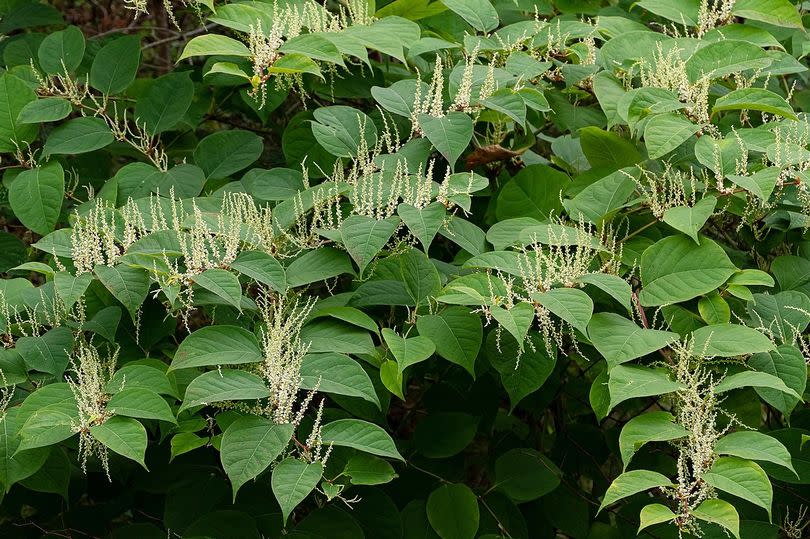Nine highly invasive plants that could become a legal problem

Invasive plant species pose a significant threat not only to the aesthetics of our gardens but to the structural integrity of properties and the well-being of native flora. It's crucial for gardeners to be aware of certain plants that are not just invasive but also illegal to let spread beyond your own borders.
Under the Weeds Act 1959, plants that are predominantly non-native are classified as invasive. An invasive plant is any species that proliferates in unwanted areas and is difficult to manage.
These plants don't necessarily have to be weeds, and being invasive doesn't automatically mean they're unattractive. Some plants available at local garden centres and nurseries can become problematic, overtaking vast spaces and overshadowing other plants in the garden.
Read more:
Create the tastiest eco-friendly garden with this Orchard Starter Bundle
Kate Middleton to draw on love of gardening for cancer recovery
Allowing any of the non-native invasive species listed to escape into the wild is a criminal offence, punishable by substantial fines.
9. Broad-leaved dock
Broad-leaved docks can disperse over great distances through various means such as wind, water, animals, and machinery. New infestations can start from buds on broken taproots.
A single broad-leaved dock plant is capable of producing up to 60,000 seeds each year, which can remain viable in the soil "for as long as 50 years", rendering full eradication a daunting task.
8. Japanese knotweed
Initially brought to the UK for its beautiful white blossoms that bloom in the warm spring and summer months, Japanese knotweed is now widespread and can spread without restriction. Despite not being able to propagate through seeds and spreading via its root system, the roots of this plant are robust and rapidly expanding. This invasive weed can significantly knock down property value by up to 20 per cent.
Getting rid of Japanese knotweed is a tough task as even a tiny piece of its root can produce an entirely new plant.
7. Green alkanet
Green alkanet is an invasive perennial often found in shady and damp areas. Despite being grown in gardens for its attractive blue forget-me-not flowers, the plant can "quickly become a weed" when grown under the right conditions.
It has the ability to self-seed, which leads to the growth of new plants close to the parent plant. Moreover, it can be spread over long distances through animal fur or clothing. It has tall, hairy stems, bristly leaves, and blue flowers with a white centre that opens from a pink bud.
6. Giant hogweed
Giant hogweed, which can grow up to 10 feet tall, resembles overgrown cow parsley. This plant, invasive to the UK, reproduces via its seeds, which are dispersed by birds, animals, and waterways.
Each bloom of this plant has the potential to yield up to 50,000 seeds, which can swiftly overrun an area, especially during flood conditions. The seeds can survive for up to two decades, necessitating continuous control measures until the soil seed bank is completely exhausted and no further growth is observed.
According to experts, it is "unlawful to allow this weed to encroach on neighbouring properties", giving you the right to take legal action if it has spread onto your property. It can also cause painful blisters to form if touched.
5. Three-cornered garlic
This invasive species, which is "illegal to plant or allow to grow in the UK" boasts white drooping flowers that produce large seeds which are attractive to ants. These ants then disperse the plant, enabling it to proliferate along roadsides, banks, verges, hedgerows, woodland and field edges, as well as on waste ground.
Its dense colonies can outcompete other spring blooms such as primroses and violets, and in some instances, it forms thick stands spreading over many metres.
4. Rhododendron ponticum
Rhododendron ponticum has "disastrous consequences" as the plant forms dense thickets and outcompetes native plants by blocking sunlight. If left uncontrolled over time, it can "dominate the habitat and eliminate all other plant life" due to its extensive root system and toxic leaf litter.
To add insult to injury, it hosts Phytophthora, a fungus-like pathogen that damages other native trees and plants. The plant generates over a million tiny seeds each year that can be dispersed by the wind.
3. Common ragwort
Also known as a "renowned weed of paddocks, pastures and waste ground", common ragwort are pretty daisy-like, yellow flowers that seem harmless to the casual observer.
But, this plant is poisonous and can cause liver poisoning in horses and livestock due to the toxin it contains. Although it is one of the most commonly found weeds in the country, its growth should be strictly controlled.
2. Spear thistle
Spear thistle has a purple, fluffy flower head that appears in summer, and the flower attracts insects and the seeds are eaten by birds. As with other thistles, these species are often considered to be weeds. It can become a nuisance on agricultural land as it produces tap roots, which grow horizontally.
The experts warned: "This alluring plant is highly invasive and poses a significant threat to other native UK species. It is remarkably adaptable and has the potential to compete with almost every plant it encounters."
1. Himalayan balsam
This plant towers above head height and "poses a significant weed problem" in gardens, according to the experts at Fantastic Gardeners.
The plant can generate massive amounts of seeds in "explosive capsules", capable of hurling seeds several metres away from the parent plant. This swift reproduction technique enables the plant to "quickly dominate its habitat". With each specimen capable of producing upwards of 800 seeds annually, the potential for growth is staggering.

 Yahoo News
Yahoo News 
